Interciencia
versión impresa ISSN 0378-1844
INCI v.31 n.3 Caracas mar. 2006
Study of nitrogen fixation by tropical legumes in acid soil from venezuelan savannas using 15n
Mingrelia España1, Evelin Cabrera-Bisbal2 and Marisol López3
1Mingrelia España. M.Sc. in Biology IVIC Ecology Center. Researcher INIA-CENIAP. Address: INIA-CENIAP Apdo. 4653 Maracay 2105 Aragua, Venezuela. e-mail: mespana@inia.gob.ve
2Evelin Cabrera-Bisbal. M.Sc. Agronomy.University of Florida, USA. Researcher INIA-CENIAP, Maracay, Venezuela. e-mail: ecabrera@inia.gov.ve
3Marisol López. M.Sc. Soil Science Universidad Central de Venezuela. Researcher INIA-CENIAP, Maracay, Venezuela. e-mail: mlopez@inia.gov.ve
Summary
In Venezuela, around 70% of cultivable land presents limitations by acid pH and low availability of P and N in the soil. Sustainable N-replenishment strategies, particularly for low-to medium-input systems on acid soil of savannas, could make use of biological N2- fixation. The object of this study was to estimate the biological nitrogen fixation (BNF) potential of various tropical legumes grown in acid soil from Venezuelan savannahs by 15N-techniques. The results suggest that the Cajanus cajan is a legume with high capacity for N2 fixation (79% N derived from the atmosphere), providing a positive N balance into the fallow system. The estimation of BNF in all legumes varied with the non-N2 fixing reference crops used, confirming that the use of an inadequate reference crop can result in erroneous estimates of BNF especially when the level of N2 fixation is low. The legume Indigosphera lespediciodes shows potential for use as an alternative green manure because of high total N accumulation and N derived from the atmosphere (62-71%). The results demonstrate that in acid soil it is possible to promote sustainability of agrosystems through the use of conservationist management practices.
Estudio de la fijación de nitrógeno por leguminosas tropicales en suelos ácidos de sabanas venezolanas utilizando 15n
Resumen
En Venezuela, alrededor del 70% de las tierras cultivables presentan limitaciones por pH ácidos y baja disponibilidad en el suelo de P y N. Estrategias sustentables para proveer N, particularmente para sistemas de bajos a medios insumos en suelos ácidos de sabanas, pudiera ser enmendado por procesos de fijación biológica de N2. El objetivo de este estudio fue estimar el potencial de fijación biológica de nitrógeno (FBN) en varias leguminosas que crecen en suelos ácidos de sabanas venezolanas a través del uso de 15N. Los resultados sugieren que Cajanus cajan es una leguminosa con alta capacidad de fijación de nitrógeno (79% de N derivado de la atmósfera), generando un balance de N positivo en el agrosistema. La estimación de FBN en todas las leguminosas estudiadas varió dependiendo del cultivo no fijador de N usado como referencia, confirmando que el uso inadecuado de un cultivo de referencia, puede resultar en estimaciones de FBN erradas, especialmente cuando el nivel de FBN es bajo. La leguminosa Indigosphera lespediciodes mostró ser una alternativa potencial para ser usada como abono verde, debido a la acumulación de N total y a la alta cantidad de N derivado de la atmósfera (62-71%). Estos resultados demuestran que en suelos ácidos es posible promover la sustentabilidad de agrosistemas a través de prácticas de manejo conservacionistas.
Estudo da fixação de nitrogênio por leguminosas tropicais em solos ácidos de savanas venezuelanas utilizando 15n
Resumo
Na Venezuela, por volta de 70% das terras cultiváveis apresentam limitaçðes por pH ácidos e baixa disponibilidade no solo de P e N. Estratégias sustentáveis para prover N, particularmente para sistemas de baixos a médios insumos em solos ácidos de savanas, pudera ser emendado por processos de fixação biológica de N2. O objetivo deste estudo foi estimar o potencial de fixação biológica de nitrogênio (FBN) em várias leguminosas que crescem em solos ácidos de savanas venezuelanas através do uso de 15N. Os resultados sugerem que Cajanus cajan é uma leguminosa con alta capacidade de fixação de nitrogênio (79% de N derivado da atmosfera), gerando um balanço de N positivo no agrossistema. A estimação de FBN em todas as leguminosas estudadas variou dependendo do cultivo não fixador de N usado como referência, confirmando que o uso inadequado de um cultivo de referência, pode resultar em estimaçðes de FBN erradas, especialmente quando o nível de FBN é baixo. A leguminosa Indigosphera lespediciodes mostrou ser uma alternativa potencial para ser usada como abono verde, devido à acumulação de N total e à alta quantidade de N derivado da atmosfera (62-71%). Estes resultados demonstram que em solos ácidos é possível promover a sustentabilidade de agrossistemas através de práticas de manejo conservacionistas.
KEY WORDS: Acid Soil, Indigosphera lespediciodes, N Fixation, 15N-technique, Pigeon pea.
Receive: 04/28/2005. Modified: 09/07/2005. Accepted: 01/16/2006.
Introduction
In Venezuela, 70% of cultivable land presents limitations by low pH and low phosphorus availability in the-soil (López and Comerma, 1985); these areas considered as marginal lands, are of low productivity for agriculture and susceptible to rapid degradation (López et al., 2001).
Acid soil deficiencies of P and N limit agricultural production in most cases (Sánchez y Logan,1992; Urquiaga y Zapata, 2000).
Sustainable N-replenishment strategies, particularly for low-to medium-input systems on acid savanna soils, could be alleviated by biological N2 fixation processes, with limited need for chemical fertilizer. A combination of indigenous phosphate rock plus legumes could be a cost-effective means of providing both P and N for sustainable crop production in the cereal-legume system (Chien, 1993).
Legumes represent a key tool in the development of sustainable agriculture, for their capacity to fix atmospheric N2 in symbiosis with Rhizobium. They can contribute substantially to the overall N economy of the system and increase the productivity of other crops when incorporated into agroecosystems, either as intercrops or as a crop within a rotation (Jiménez-Zacarias and Peña-Cabriales, 2000; Mafongoya et al., 2004). Legumes are used as green manure in many farming systems and the benefit to a subsequent crop depends on the quantity of biologically fixed N2 and the proportion of residual N left over for the subsequent crop (Ramos et al., 2001). The amount of N that grain legumes contribute in rotation crops is smaller than that of green manure legumes, because much of the N is removed in the grain. However, the grain legumes are often much more attractive to farmers, because they contribute directly to the household food supply (Mafongoya et al., 2004).
Different methods have been developed to measure biological N2 fixation (BNF) and the choice of a particular one depends on the type and site of the experiment, the available resources and the species and system in question (Gathumbi et al., 2002). The enrichment of soil 15N methods is particularly useful when a relatively less sensitive analytical facility, like optical emission spectrophotometry, is used (Azam and Farooq, 2003). The principal assumption of these methods is the equality (15N-dilution or classical method) or proportionality (A-value method) of the ratio of fertilizer N to soil-derived N in fixing and reference plants (Chalk, 1996). The A-value method has generated controversy since its inception, with disagreement about its dependency on yield, and its disadvantages have been identified in the literature (Boddy and Urquiaga, 1992; Chalk, 1996). However, the concept has been widely used for more than 25 years (e.g. Fried and Broeshart, 1975; Hardarson and Danso, 1990; Campillo et al., 2003). This approach may be particularly applicable under conditions of low N availability (nutrient-deficient and marginal soils), when the growth of a non-fixing reference crop is uncharacteristically low, thereby making the use of 15N isotopic technique invalid (Azam and Farooq, 2003). The application of the isotopic technique (15N) as a tool for the evaluation of fixed N has concentrated on legumes of nutritive importance, one of the main sources of proteins and carbohydrates in Latin America. Recently, experimental studies have applied the isotopic technique to measure BNF in other legumes such as woody forage and wild species that are used as green manure, cover crops, and for conservation and improvement of soil (Farías Rodríguez and Peña-Cabriales, 2000).
The aim of the present study was to evaluate the biological nitrogen fixation of different tropical legumes in Venezuelan acid soil using 15N-techniques. A field experiment was carried out to estimate the BNF of Pigeon pea (Cajanus cajan) and a greenhouse experiment to evaluate the proportion of BNF in four different tropical legumes.
Materials and Methods
Field and greenhouse experiments were carried out to assess BNF in pigeon pea (Cajanus cajan) and four tropical legumes, respectively.
Field experiment
Experimental site. The field experiment was performed on an acid soil in the State of Guárico, Venezuela, savanna (8º33'59''N, 66º05'10''W). The area is characterized by annual precipitations of 800-1000mm, distributed in 5 to 6 months. The rains are erratic, of high intensity and duration. The soil is a Typic Paleustuls, Kaolinite, isohiperthermic, loam sand. During the period of evaluation, the rains oscillated from 800 to 1277mm, with an unimodal time distribution with a maximum in July (215.1mm). The mean temperature varied between 25 and 30ºC
Experimental soil (0-20cm) characterization. The main chemical, physical and biological properties of experimental soil were: pH (soil-water 1:2.5)= 4.5-5.0; P-Olsen= 2mg·kg-1; K-Olsen= 22mg·kg-1; Ca-Morgan= 80mg·kg-1; Mg-Morgan= 22mg·kg-1) and Al saturation= 62%; ISP= 0.08-0.11 (very high reparability); Da= 1.45-1.85Mg·m-3; EPT= 29.51-46.46%; porosity index= 0.42-0.74; textural group: sandy and loam sand (s, ls), 81.9% sand, 9.99% silt and 8.11% clay; organic matter= 10g·kg-1; 0-10% of root colonized by mycorrhiza (very low). These data are indicative of severe degradation severity and very low productive capacity of the experimental soil.
The legume evaluated was pigeon pea (Cajanus cajan cv. Aroita). Sorghum (Sorghum bicolor cv. Chaguaramas VII), a non-N2-fixing plant, was used as a reference crop. At 15 days after planting (DAP), the plots of pigeon pea were amended with (per ha) 15kg N as 15N-ammonium sulphate (10% 15N atoms), 100kg P as phosphoric rock and 45kg K as potassium chloride (KCl). For the reference crop, 120kg N as 15N-urea (5% 15N atoms), 100kg P as phosphoric rock and 60kg K as potassium chloride (KCl) were added per ha.
Experimental design. The plots were of 4.2×2.0m (8.4m2) for pigeon pea and 2.7×2.0m (5.4m2) for sorghum, with plant spacing of 0.2 by 0.7m and 0.2 by 0.45m, respectively. The plots were arranged in a randomized complete design with six replicates, which were 15N-labelled to obtain BNF data.
Harvest and plant analysis. The plants were harvested at 100 DAP. All plants were separated into grain and stover, dried at 65ºC, weighed and ground. Samples were taken from a central area of 1m2 of the 15N-labelled plots and analyzed for total N content using the semi-micro Kjeldahl procedure. The 15N enrichment was determined using an NOI-6 emission spectrometer (FAO/OIEA, 1987). The estimation of BNF was determined using the A-value method, which is based on the assumption that the assimilation of N by plants from soil, fertilizer and atmosphere is in direct proportionality to the N available from each source. The percentage of plant N derived from BNF (%Nddfa) was calculated using the equations from Hardarson and Danso (1990) and Danso (1995):
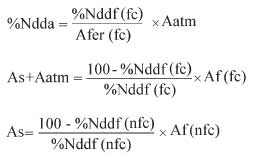
where Nddf: plant N derived from fertilizer, FC: fixing crop, NFC: non-fixing crop, Aatm: amount of N available from atmosphere (atm), soil (s) or fertilizer applied (f).
Greenhouse experiment
Soil, legumes and reference crops. The experiment was carried out in a greenhouse located at INIA-CENIAP, Maracay, Venezuela. Free-draining pots filled with 4kg of soil (Typic Paleustuls, Fg, kaolinite, isohiperthermic) collected at the same location of the field experiment, in Guárico state, Venezuela. It was air dried, mixed, homogenized and sieved (<4mm). The soil was amended with 15N-labelled at a rate of 14.63mg of N per pot for the legumes, while that for the reference crop received 117.07mg N, as 15N-ammonium sulphate (10% 15N atoms), 97.56mg of P as phosphoric rock and 58.54mg of K as potassium chloride (KCl).
The legumes studied were two grain legumes, soybean (Glycine max L.) and pigeon pea (Cajanus cajan), and two green manure legumes, sunnhemp (Crotalaria juncea L.) and indigosphera (Indigosphera lespediciodes). Three non-N2-fixing plants were used as reference crops, maize (Zea maiz), sorghum (Sorghum bicolor L. Mohen) and non-inoculated soybean (Glycine max. L.). The plants were inoculated with specific Rhizobium or Bradyrhizobium strains for each legume; the strains used were Ceniap 19, Ceniap 41, Ceniap 43 and Ceniap 47 for soybean, indigosphera, pigeon pea and sunnhemp, respectively from the Ceniap collection. The inoculants were prepared in a sterile yeast extract mannitol solution (~109cfu·ml-1), which were applied after germination of the seeds.
Experimental design. The seven treatments (four legume treatments and three reference crops) with five replicates were installed under a randomized design.
Harvest and plant analysis. At 45 DAP the plants were harvested, and the shoot and root were separated. All plant organs were dried at 65ºC, weighed and ground. The plant samples were analyzed for total N content, 15N/14N isotopic ratio and the estimation of BNF was made using the methods described in the field experiment.
Results and Discussion
Field experiment
The dry matter and N accumulation data for the legume and reference crop are presented in Table I. The dry matter yield for the sorghum was 2584kg·ha-1 and total N accumulation was 40.76kg·ha-1. The grain contributes 29.66kg·ha-1, indicating that the quantity of nitrogen exported by the grain represents almost 75% of the total accumulated N, which indicates that sorghum has a high N harvest index. For the pigeon pea, dry matter yield of 2823kg·ha-1 with a yield grain of 739.33kg·ha-1 reflects a low accumulation of nitrogen of 62.06 kg·ha-1. In this case the quantity of nitrogen removed in grain was 24.43 kg·ha-1 (40%). The N harvest index in this legume is smaller than other grain legumes such as soybean, which can export in the grain over 70% of total N, sometimes leaving a negative N balance in the system (España et al, 2000).
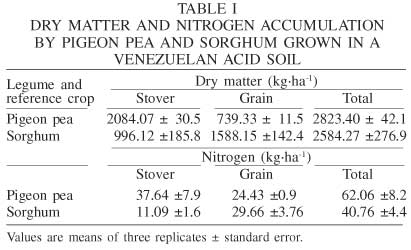
The results of the efficiency of N recovery from the fertilizer (ERF) by pigeon pea and sorghum are shown in Table II. The sorghum ERF of 18.79% indicates that, out of the quantity of N applied as fertilizer (120kg·ha-1), the crop took up 22.54kg·ha-1, which represents 55.3% of the total N, suggesting that the difference comes from N in the soil. In the case of the pigeon pea, an ERF of 11.42% of the 15kg·ha-1 applied as fertilizer implies that the highest proportion of the N of the legume was derived from BNF (48.87kg·ha-; 78.87% of the total N). This value indicates that the pigeon pea is a legume with high N2 fixation capacity. Lower values of BNF (62 and 55-67%) for pigeon pea in a field experiment in Kenya have been reported by Mafongoya et al. (2004) and Gathumbi et al. (2002), respectively.
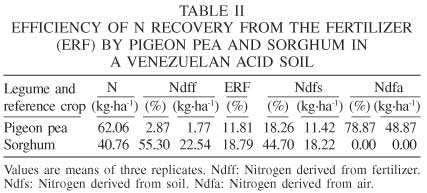
The N contribution made by legumes in agroecosystems is linked to the decay of crop residues root, nodules and fallen litter (Mafongoya et al., 2004). The contribution of N2-fixation to the overall N balance of a soil can be summarized as the amount of N derived from N2-fixation minus the amount of N exported (Gathumbi et al., 2002). In this study the pigeon pea showed a positive N balance, providing additional N inputs of 24.44kg N per ha into the fallow system, with 50% of the N derived from fixation.
Greenhouse experiment
The dry matter and N yields are shown in Table III. The grain legumes and green manure legumes did not show significant differences in dry matter yield. However, the sunnhemp had the lowest quantity of dry matter (5.80g per pot) whereas the pigeon pea had the highest value (7.42g per pot). When these results are compared with the non-N2 fixation reference crops used, the sorghum showed higher dry matter (14.88g) than maize (12.16g) and soybean non-inoculated (6.57g). For total N, soybean and indigosphera accumulated more N than pigeon pea and sunnhemp. Of the reference crops, maize had the lowest value of total N, as compared with non-inoculated soybean and sorghum.
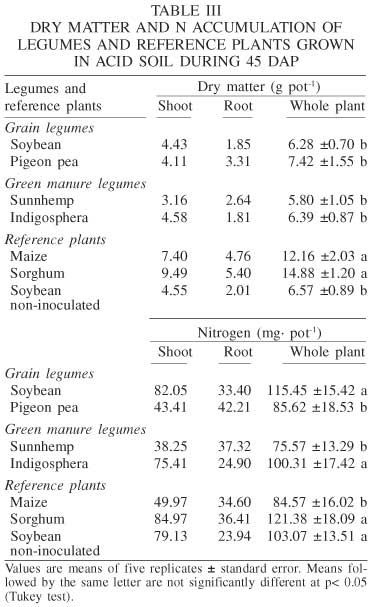
In general, these values are lower than those reported by other authors. Okito et al. (2004) obtained under similar experimental conditions, dry matter accumulation for soybean and sunnhemp of 40-77 and 72-112g per pot, respectively, at 90 DAP. In this study, the difference may have been, besides plants being harvested at 45 DAP, the acid soil of low fertility in which the plants were grown, even considering the added P and K. Gathumbi et al. (2002) showed that pigeon pea accumulated, at 60 DAP, 45 and 42% of the dry matter and N, respectively, of the total accumulated at 90 DAP. Thomas et al. (1997) reported, in a study on an acid soil from a savanna in Colombia, that the amounts of N fixed by forage legumes in low fertility acid soils depend upon legume growth, soil type and level of fertilization.
The estimations of the BNF (%) by the legumes, using each of three reference crops, are shown in Table IV. Soybean showed the highest BNF (67.65-75.51%), followed by indigosphera (62.29-71.46%), whereas pigeon pea and sunnhemp had lower percentages. España et al. (2000) reported BNF values for soybean in Venezuela of 54-67%. Further, in a field experiment, in the same place where the experimental soil was collected, the indigosphera (native legume) gave values of BNF of 88% indicating that it is a suitable alternative for use as a green manure legume in acid soil of this area (data not shown). In a study conducted in Cuba, Ramos et al. (2001) reported estimations of BNF for sunnhemp of 27 and 39% using as reference crops maize and sorghum, respectively.
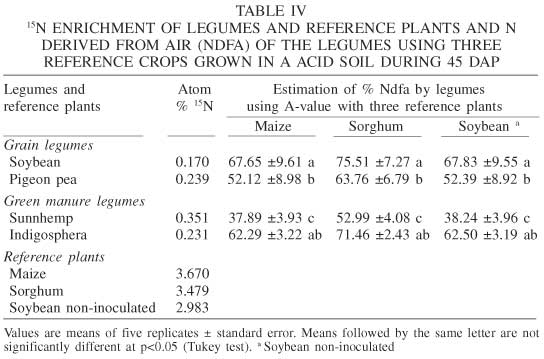
In the present experiment, the estimation of BNF in all legumes varied with the non-N2 fixation reference crops used. It was very similar using non-inoculated soybean and maize. However, using sorghum as reference crop, the proportions derived from N2-fixation were larger and the magnitude of this difference depended on the legumes. In soybean the difference was 7%, but for sunnhemp (with low N2-fixation) the BNF using different reference crops was considerably higher (15%). These data confirm that the use of an inadequate reference crop can result in erroneous estimates of BNF, especially when the level of N fixation is low. In this sense, Hardarson et al. (1988) mentioned that when the fixation is high, the errors due to the use of inadequate reference crops are generally smaller.
The estimations of the N derived from air, soil and fertilizer by legumes, using each reference crop, are shown in Figure 1. The data reveals that in both grain legumes and green manure legumes, the N derived from the fertilizer (ndff) was low (1.97 to 2.5mg N per pot). Larger amounts of N derived from air were accumulated by soybean among the grain legumes (78.10-87.18mg N) and by indigosphera among the green manure legumes (62.48-71.68mg) Lower values were obtained in sunnhemp (28.63-40.04mg N), which presented the highest values of soil-derived N (4.16 and 44.43mg) using maize and sorghum as reference crops, representing more than 50% of the N accumulated. Similar results have been reported by Ramos et al. (2001), who showed that a high proportion (71-74%) of total N accumulated by sunnhemp was derived from the soil. The green manure legumes generally vary with respect to the efficiency of N2 fixation and total N yields, which affect the total quantity of BNF (Hardarson, 1998).
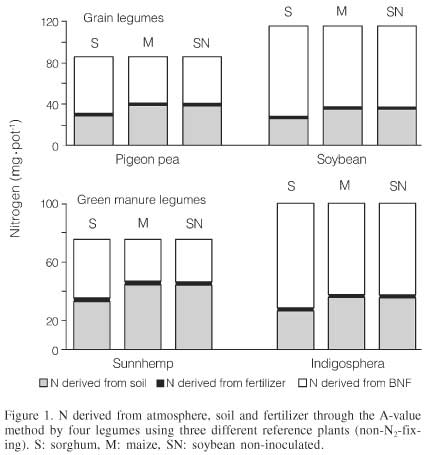
Conclusions
The experimental results indicate that the Cajanus cajan shows a good potential to be used as a grain legume in rotation systems under acid soil, promoting the sustainability of agrosystems because of its high efficiency for N2-fixation and low N harvest index, thus contributing to a positive N-balance. The legume Indigosphera lespediciodes is a potential alternative for use as green manure because of high total N accumulation and N derived from the atmosphere.
The results demonstrate that it is possible to promote the sustainability of agrosystems in acid soil through the employment of conservationist management practices, avoiding the excessive use of amendments that could affect the fertility of these soils.
Acknowledgements
The authors thank Manuel De Jesús Mujica and María Paredes for technical assistance, Juan Carlos Rey for soil classification, Manuel Salas and Héctor Mena for the supply of seeds, and Gary Bending from Warwick HRI, University of Warwick, UK for revision of the manuscript. The work was undertaken as part of research project "Development of Management Practices for Sustainable Crop Tropical Production Systems on Acid Soils Through the Use of Nuclear and Related Techniques" (VEN 10962R INIA-OIEA-FAO).
REFERENCES
1. Azam F, Farooq S (2003) An appraisal of methods for measuring symbiotic nitrogen fixation in legumes. Pakist. J. Biol. Sci. 6: 1631-1640. [ Links ]
2. Boddy RM, Urquiaga S (1992) Calculations and assumptions involved in the use of the "A-value" and 15N isotope dilution techniques por the estimation of the contribution of plant-associated biological N2 fixation. Plant and Soil. 145:151-155. [ Links ]
3. Campillo R, Urquiaga S, Pino I (2003) Estimate of the biological fixation of nitrogen in leguminous forrajeras by means of the methodology of the 15N. Tech. Agric. 63: 169-179. [ Links ]
4. halk P (1996) Estimation of N2 fixation by 15N isotope dilution-The A-value approach. Soil Biol. Biochem. 28: 1123-1130. [ Links ]
5. Chien SH (1993) Solubility assessment for fertilizer containing phosphate rock. Fertil. Res. 35: 93-99. [ Links ]
6. Danso SKA (1995) Assessment of biological nitrogen fixation. Fertil. Res. 42: 33-41. [ Links ]
7. España M, Bisbal E, Rodríguez B (2000) Evaluación de la fijación de nitrógeno en soya en dos sistemas de labranza mediante la utilización de 15N. In Peña-Cabriales JJ (Ed.) La fijación biológica de nitrógeno en América Latina: El aporte de las técnicas isotópicas. Improsa-OIEA-ARCAL. Irapuato, Gto. México. pp. 117-120. [ Links ]
8. FAO/OIEA (1987) Manual de laboratorio, métodos para análisis de 15N. OIEA. Viena, Austria. 122 pp. [ Links ]
9. Farías Rodríguez R, Peña-Cabriales JJ (2000) Uso de las técnicas nucleares en la fijación biológica de nitrógeno en México. In Peña-Cabriales JJ (Ed.) La fijación biológica de nitrógeno en América Latina: El aporte de las técnicas isotópicas. Improsa-OIEA-ARCAL. Irapuato, Gto., México. pp. 101-108 [ Links ]
10. Fried M, Broeshart H (1975) An independent measurement of the amount of nitrogen fixed by a legume crop. Plant Soil 43:707-711 [ Links ]
11. Gathumbi SM, Cadisch G, Giller KE (2002) 15N natural as a tool for assessing N2-fixation of herbaceous, shrub and tree legumes in improved fallows. Soil Biol. Biochem. 34:1059-1071. [ Links ]
12. Hardarson G, Danso SKA (1990) Use of 15N methodology to assess biological fixation. In Hardarson G (Ed.) Use of nuclear techniques in studies of soil-plant relationships. Training course. Series Nº2. IAEA. Vienna, Austria. pp. 173-216. [ Links ]
13. Hardarson G, Danso SKA, Zapata F (1988) Nitrogen fixation measurements in alfalfa-ryegrass swards using nitrogen-15 and the influence of the reference crop. Crop Sci. 28:101-105. [ Links ]
14. Jiménez-Zacarías J, Peña-Cabriales JJ (2000) Fijación biológica de N2 (FBN) en leguminosas de América Latina. In Peña-Cabriales JJ (Ed.) La fijación biológica de nitrógeno en América Latina: El aporte de las técnicas isotópicas. Improsa-OIEA-ARCAL. Irapuato, Gto., México. pp. 1-16. [ Links ]
15. López M, Mena H, Moreno B (2001) Efecto de la fertilización fosfatada y abonos verdes sobre la productividad del sorgo (Sorghum bicolor L. Moench). Memoria XVI Cong. Venez. Ciencia del Suelo. 6 pp. [ Links ]
16. López de RI, Comerma J (1985) Caracterización de los Suelos Ácidos de Venezuela Basada en Algunas Propiedades Físicas y Químicas. Agronomía Tropical 35 (1-3): 83-110. [ Links ]
17. Mafongoya P, Giller KE, Odee D, Gathumbi S, Ndufa SK, Sitompul SM (2004) Benefiting from N2-fixation and managing rhizobia. In Van Noordwijk, Cadisch G, Ong CK (Eds.) Below-ground interactions in tropical agroecosystems. Concepts and models with multiple plant components. CABI. Wallingford, UK. pp. 227-242. [ Links ]
18. Okito A, Alves BRJ, Urquiaga S, Boddey RM (2004) Isotopic fractionations during N2 fixation by four tropical legumes. Soil Biol. Biochem. 36:1170-1190. [ Links ]
19. Ramos M, Villatoro MA, Urquiaga S, Alves B, Boddey R (2001) Quantification of the contribution of biological nitrogen fixation to tropical green manure crops and the residual benefit to a subsequent maize crop using 15N-isotopic techniques. J. Biotechnol. 91: 105-115. [ Links ]
20. Sánchez PA, Logan TL (1992) Myths and Science about the chemistry and fertility of soils in the tropics. In: Lal R. and Sánchez P.A: 8º Eds. Myths and Science of soil of the Tropics, SSSA Special Publication Nº 29 SSSA Inc. and Asa Inc. Madinson, Wisconsin. USA. pp 35-46. [ Links ]
21. Thomas R, Asakana NM, Rondón MA, Alarcón HF (1997) Nitrogen fixation by three tropical forage legumes in an acid-soil savanna of Colombia. Soil Biol. Biochem. 29: 801-808. [ Links ]
22. Urquiaga S, Zapata F (2000) Eficiencia de la fertilización nitrogenada y su relación con la productividad agrícola sostenible. In Urquiaga S, Zapata F (Eds.) Manejo eficiente de la fertilización de cultivos anuales en América Latina y el Caribe. Génesis. Rio de Janeiro, Brazil. pp: 19-23. [ Links ]












 uBio
uBio 
